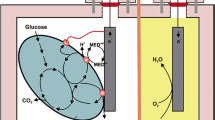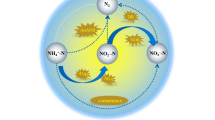Abstract
In the present work the kinetics of ferric reduction was investigated using dissimilatory ferric- and sulphate-reducing bacterial cultures. The effect of sulphate reduction on Fe(III) reduction was also studied. The study is an attempt to improve the biological reduction rate of Fe(III) as an alternative biotechnological way to the reduction step in steelmaking processing operations. The results obtained show that the reduction of ferric iron and sulphate took place in a successive way and none synergetic effect was detected. The simultaneous action of both metabolic activities did not enhance the process but slowed down the kinetics of ferric reduction. The reduction process of 3 g/L of soluble ferric and 3 g/L of sulphate lasted 25 days. Ferric iron was the first electron acceptor to be reduced in the first 15 days followed by the sulphate reduction in the following 10 days. That result suggests that ferric reduction is a preferential metabolic process over sulphate reduction when both electron acceptors coexist. None improvement in the kinetics was observed using an electron donor concentration in excess. In contrast, the total reduction of ferric ion (3 g/L) with adapted bacterial cultures was achieved in only 36 h. The presence of sulphate had no effect on the ferric reduction. Finally, an improved culture medium for ferric-reducing bacteria is also proposed.












Similar content being viewed by others
References
Balch, W. E., & Wolfe, R. S. (1976). New approach to the cultivation of methanogenic bacteria: 2-mercaptoethanesulfonic acid (HS-CoM)-dependent grown of Methanobacterium ruminatium in a pressurized atmosphere. Applied and Environmental Microbiology, 32, 781–789.
Balch, W. E., Fox, G. E., Magrum, L. J., Woese, C. R., & Wolfe, R. S. (1979). Methanogens: reevaluation of a unique biological group. Microbiological Reviews, 43, 260–296.
Coates, J. D., Lonergan, D. J., Phillips, E. J. P., Jenter, H., & Lovley, D. R. (1995). Desulfomonas palmitatis sp. nov., a marine dissimilatory Fe(III) reducer that can oxidize long-chain fatty acids. Archives of Microbiology, 164, 406–413.
Coates, J. D., Phillips, E. J. P., Lonergan, D. J., Jenter, H., & Lovley, D. R. (1996). Isolation of Geobacter species from diverse sedimentary environments. Applied and Environmental Microbiology, 62(5), 1531–1536.
Cummings, D. E., March, A. W., Bostick, B., Spring, S., Caccavo, F., Jr., Fendorf, S., et al. (2000). Evidence for microbial Fe(III) reduction in anoxic, mining-impacted lake sediments (Lake Coeur d'Alene, Idaho). Applied and Environmental Microbiology, 66(1), 154–162.
Kolmert, A., Wikström, P., & Hallberg, K. B. (2000). A fast and simple turbidimetric method for the determination of sulphate in sulphate-reducing bacterial cultures. Journal of Microbiological Methods, 41, 179–184.
Li, Y., Vali, H., Yang, J., Phelps, T. J., & Zhang, C. (2006). Reduction of iron oxides enhanced by sulphate-reducing bacterium and biogenic H2S. Geomicrobiology Journal, 23, 103–117.
Lovley, D. R. (2003). Cleanning up with genomics: applying molecular biology to bioremediation. Nature Reviews/Microbiology, 1, 36–44.
Lovley, D. R., & Phillips, E. J. P. (1986a). Organic matter mineralization with reduction of ferric iron in anaerobic sediments. Applied and Environmental Microbiology, 51(4), 683–689.
Lovley, D. R., & Phillips, E. J. P. (1986b). Availability of ferric iron reduction for microbial reduction in bottom sediments of the freshwater tidal Potomac River. Applied and Environmental Microbiology, 52(4), 751–757.
Lovley, D. R., & Phillips, E. J. P. (1987a). Rapid assay for microbially reducible ferric iron in aquatic sediments. Applied and Environmental Microbiology, 53, 1536–1540.
Lovley, D. R., & Phillips, A. J. P. (1987b). Competitive mechanisms for inhibition of sulphate reduction and methane production in the zone of ferric iron reduction in sediments. Applied and Environmental Microbiology, 53(11), 2636–2641.
Lovley, D. R., & Phillips, A. J. P. (1992). Reduction of uranium by Desulfovibrio desulfuricans. Applied & Environmental Microbiology, 58(3), 850–856.
Lovley, D. R., Roden, E. E., Phillips, E. J. P., & Woodward, J. C. (1993). Enzymatic iron and uranium reduction by sulphate-reducing bacteria. Marine Geology, 113, 41–53.
Madigan, T. M., Martinko, J. M., & Parker, J. (2003). Brock. Biology of microorganisms. Upper Saddle River: Pearson Education. ISBN: 0-13-066271-2.
Nevin, K. P., & Lovley, D. R. (2002). Mechanisms for accesing insoluble Fe(III) oxide during dissimilatory Fe(III) reduction by Geotrix fermetans. Applied & Environmental Microbiology, 68(5), 2294–2299.
Orth, A., Anastasijevic, N., & Eichberger, H. (2007). Low CO2 emission technologies for iron and steelmaking as well as titania slag production. Minerals Engineering, 20, 854–861.
Postgate, J. R. (1984). The Sulphate-reducing Bacteria. London: Cambridge University Press.
Poulton, S. W., Krom, M. D., & Raiswell, R. (2004). A revised scheme for the reactivity of iron (oxyhydr)oxide minerals towards dissolved sulphide. Geochemica et Cosmochimica Acta, 68(18), 3703–3715.
Robles-Arenas, V.M. (2007) Caracterización hidrogeológica de la Sierra de Cartagena-La Unión (SE de la Península Ibérica). Impacto de la minería abandonada sobre el medio hídrico. Tesis Doctoral. Universidad Politécnica de Cataluña.
Schroeder, P., & Ladd, L. (1991). Slowing the increase of atmospheric carbon dioxide: a biological approach. Climatic Change, 19, 283–290.
Stookey, L. L. (1970). Ferrozine—a new spectrophotometric reagent for iron. Anal Chemistry, 42, 779–781.
Teir, S., Eloneva, S., & Zevenhoven, R. (2005). Production of precipitated calcium carbonate from calcium silicates and carbon dioxide. Energy Conversion & Management, 46, 2954–2979.
Teir, S., Kuusik, R., Fogelholm, C. J., & Zevenhoven, R. (2007). Production of magnesium carbonates from serpentinite for long-term storage of CO2. International Journal of Mineral Processing, 85(1–3), 1–15.
Vanbroekhoven, K., Van Roy, S., Ryngaert, A., Diles, L., & Dejonghe, W. (2006). Competitive dissimilatory iron reduction during in situ bioprecipitation of metals. Geophysical Research Abstracts, 8, 08498.
Acknowledgements
The authors thank the financial support of two Spain institutions: Ministerio de Educación y Ciencia, through the “Plan Nacional de Educación y Ciencia” (project reference, CTM 2005-02450).
Author information
Authors and Affiliations
Corresponding author
Rights and permissions
About this article
Cite this article
García-Balboa, C., Cautivo, D., Blázquez, M.L. et al. Successive Ferric and Sulphate Reduction using Dissimilatory Bacterial Cultures. Water Air Soil Pollut 207, 213–226 (2010). https://doi.org/10.1007/s11270-009-0130-9
Received:
Accepted:
Published:
Issue Date:
DOI: https://doi.org/10.1007/s11270-009-0130-9




